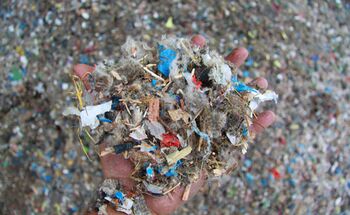Refuse Derived Fuel
A type of Waste Derived Fuel, Refuse Derived Fuel or RDF has been prepared by a treatment process to produce a broad specification fuel, which is still considered to be a waste, that can be used by an EfW plant supplied under a Fuel Supply Agreement. The specification will depend upon the plant to be used, but typically at the most basic level will have had metals and inert materials removed, removal of some recyclables and limited shredding/bag splitting. More refined RDF will have had drying, shredding to a uniform size and Moisture Content reduction. At the very high end of production the RDF will move towards being a Solid Recovered Fuel (SRF).

Context
A type of Waste Derived Fuel, Refuse Derived Fuel or RDF has been prepared by a treatment process to produce a broad specification fuel, which is still considered to be a waste, that can be used by an EfW plant supplied under a Fuel Supply Agreement. The specification will depend upon the plant to be used, but typically at the most basic level will have had metals and inert materials removed, removal of some recyclables and limited shredding/bag splitting. More refined RDF will have had drying, shredding to a uniform size and Moisture Content reduction. At the very high end of production the RDF will move towards being a Solid Recovered Fuel (SRF). For the purposes of legislation RDF remains a waste (unless stringent End of Waste Criteria can be met) and so users of the fuel have to comply with the IED which has superseded WID.
Composition of Refuse Derived Fuel
We have pulled together a number of specification (spec) sheets to produce give an overall feel for the spec of Refuse Derived Fuel, as shown in the table below. In reality the spec is usually a function of the receiving plant.
| Measure | Units | Residual Waste[1] | RDF |
|---|---|---|---|
| Net Calorific Value | MJ/kg (as received) | 9 - 15 | 10 - 15 |
| Moisture | wt% (dry basis) | 10 - 40 | <20 |
| Biomass Content[2] | wt% (dry basis) | >45 | >65 |
| Ash Content | wt% (dry basis) | 10 - 30 | <20 |
| Sulphur | wt% (dry basis) | < 0.85 | <0.5 |
| Nitrogen | wt% (dry basis) | <1.5 | <0.8 |
| Lead | mg/kg | <200 | <100 |
| Chlorine CI | wt% (dry basis) | <1.2 | <0.6 |
| Zinc[3] | wt% (dry basis) | <0.1 | |
| Sodium and Potassium[3] | wt% (dry basis) | <0.8 | |
| Mercury | mg/kg | <2 | <1 |
| Nickel | mg/kg | <200 | <100 |
| Thallium | mg/kg | <20 | <10 |
| Ferrous and non-ferrous metals | wt% (dry basis) | <7 | <3 |
| Non combustible material | wt% (dry basis) | <15 | <10 |
| Glass | wt% (dry basis) | <5 | <2 |
| Dust <1mm | wt% (dry basis) | <5 | <5 |
| Bulk Density (loose) | kg/m3 | 100 - 275 | 100 - 175 |
| Particle Size (max dimension) | mm | 500 | 300 |
Chlorine is a particular issue due to its tendency to form Hydrochloric Acid in an energy recovery process, which then requires specific abatement/clean-up technologies. With limited such arrangements in Cement Kilns this means that they generally have a lower tolerance for Chlorine closer in a final specification to SRF.
Background to Export of Refuse Derived Fuel
The movement of RDF from the UK, primarily in the EU, commenced in c.2010 and progressively grew up until around 2016 driven by supply-demand and landfill tax in the UK and the economics and spare capacity of EfW plants in the EU. From around 2017 tonnages for export started to drop, with more pronounced drops from 2018 as the supply-demand patterns changed in the UK, some EU countries started to implement taxation on EfW and the cost and complexities of transportation following Brexit increased. The two charts below show the overall patterns of export:
| CIWM Presidential Report (2018) Showing Grow in RDF and SRF Export[4] | Analysis by Monksleigh of RDF and SRF Exports from England from EA Data |
Moving Refuse Derived Fuel from the UK abroad requires compliance with the Transfrontier Shipment Regulations (TFS) and in simple terms requires an application for movement to be made to the relevant authorities that requires a number of key measures to be satisfied before this can occur. It also requires the user of the fuel to be classified as an R1 facility.
Annual Export from England
to add
Month on Month Export
to add
Year on Year Differences
to add
Exporters
to add
